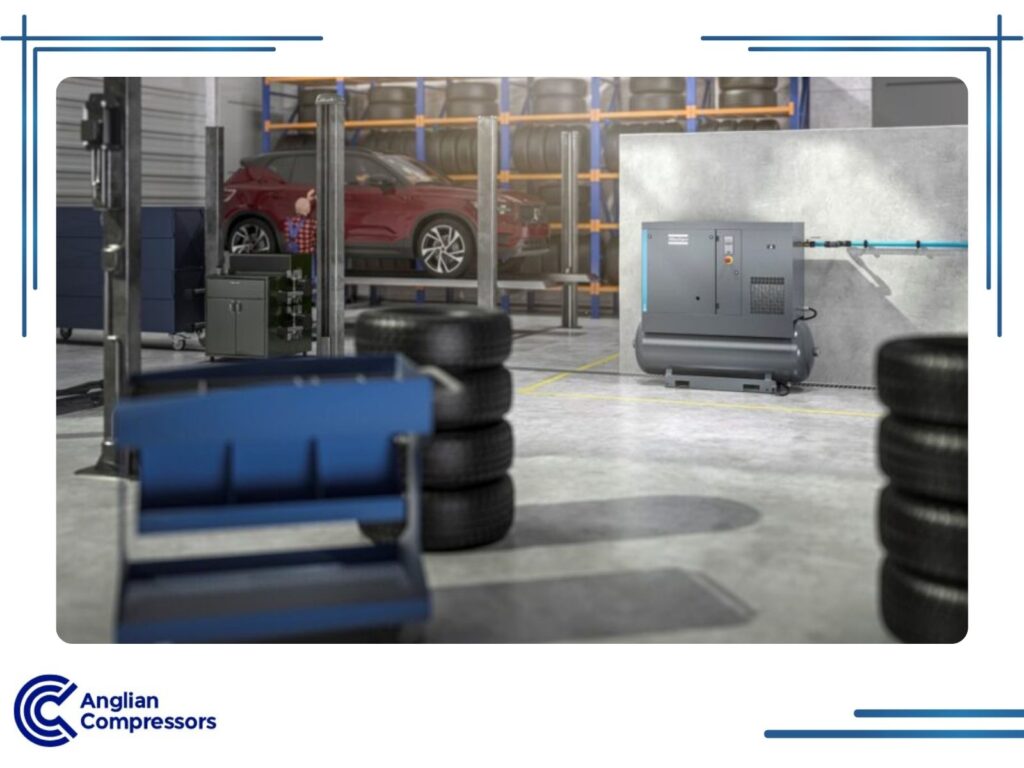Why compressed air leak detection matters – and how to maximise its benefits
Compressed air systems include not just the compressor but also the pipes, valves, and other parts. While air production is essential, air leakage is costly to these systems. Even a minor 3 mm gap can lead to a pressure drop and a loss of approximately 7.1 litres/second at 7 bar pressure, resulting in annual energy costs exceeding £10,500 and over 15 tonnes of CO2 emissions.
Considering how versatile compressed air can be, it is no surprise that it is an essential resource in many industries and factories. Compressed air is everywhere, whether used to power pneumatic tools, robots, and conveyor belts or for cleaning, drying, and painting. Leak detection matters not only for maximising profitability but also for ensuring system safety and reducing environmental impact.
The older the system is, the likelier it is to suffer from air leaks. Valves get left open by mistake, fittings become looser, or pipes are no longer airtight. Being able to pinpoint leaks in a busy production facility with considerable background noise is like finding a needle in a haystack, without specialised equipment to locate leaks efficiently.
Why Should a Business Be Concerned About Air Leaks?
Facilities relying on compressed air should be cautious about the inefficiencies caused by air leaks. Notable pressure drops from leaks interfere with workflow, reducing overall plant efficiency. For older systems, compressed air leakage can account for 20–30% of total energy use.
The Compressed Air & Gas Institute estimates that air leaks waste up to 30 billion kilowatt-hours annually worldwide, contributing significantly to financial and environmental losses.
The Environmental Impact of Air Leaks
Compressed air leaks result in direct energy losses and increased CO2 emissions. For instance, in the UK alone, compressed air accounts for 10% of industrial energy use, and leaks represent a significant portion. Beyond carbon dioxide, leaks release pollutants like methane and volatile organic compounds, compounding environmental damage.
The amount of CO2 emitted by air leaks is significant. According to the Compressed Air & Gas Institute, air leaks account for an estimated 10% of all industrial CO2 emissions in the United States. This is equivalent to the emissions of 100 million cars.
In addition to CO2, compressed air leaks release other pollutants into the atmosphere, such as methane, nitrous oxide, and volatile organic compounds. These pollutants can contribute to smog, acid rain, and other environmental problems.
Global Energy Consumption and Leakage
The global energy consumption for compressed air generation is approximately 100 billion kilowatt-hours annually, up to 30% of which is wasted due to leaks. Energy-efficient solutions, such as oil-free air compressors and modern ultrasonic detectors, can significantly reduce these losses.
What Are the Potential Losses from Air Leaks at a Facility?
The potential financial consequences of leaking compressed air vary depending on a few factors:
- Size of the source of the leak.
- BAR pressure level.
- Power is used to produce the compressed air at the required pressure level.
- The number of hours the air compressor system is operational weekly.
If we use an example of a 3mm diameter hole, using 7 bar of pressure, with equipment operational for 120 hours per week, the potential air leakage is 7.1 l/s, and the energy loss would potentially be over £10,512 annually. Also, from an environmental standpoint, this potentially equates to over 15 tonnes of wasteful CO2 emissions.
Whilst the diameter size of air holes will vary, the larger, older, and more complex the compressed air distribution system is, the greater the potential for multiple air leaks. Simply put, if there’s one leak somewhere, then there are probably many others, too.
Indeed, most systems won’t remain airtight forever. However, isolating and resolving most air leaks is possible by using the latest ultrasonic detectors.
Indirect Consequences of Using Leaking Compressed Air Systems
Compressor systems using more energy than necessary due to air leakage problems don’t only operate at a higher cost. The equipment must attempt to compensate for air pressure losses within the system, or operate longer than ordinarily necessary, putting the equipment under more significant strain. This leads to more maintenance costs, repairs, and replacement parts.
Irregular air pressure levels cause sensitive air-operated tools to sputter and occasionally stop. This is the same for the whole operating system in factories. Stoppages or air tools no longer running at peak efficiency affect staff operator morale and add to operating costs.
Plant managers worry about the inconvenience of obtaining a detailed report on air leaks and whether it’ll pay for itself in future energy-saving returns. Yet this ignores the reality that many compressed air setups develop costly leaks over time. Ignorance isn’t bliss in this case. Instead, the losses are all but silent except for the occasional hissing sound heard over the operational din.
Air leakage does not only result in energy waste. The increased strain on compressors leads to higher maintenance costs and more frequent repairs. Fluctuating pressure levels can disrupt tools and cause production delays. Implementing modern energy-saving technologies like variable speed drive (VSD) compressors helps offset these issues while ensuring a stable air supply.

Worst Culprits for Air Leakage in a Compressed Air System
Just like there isn’t usually one air leak discovered during a leak detection survey, the same is true for the source of air leakages.
Here are a few of the more common sources in an industrial setting:
- Old pipes.
- Joints connecting long stretches of pipe
- Leaky pressure regulators.
- Couplings, seals, flanges, or hoses are not airtight due to dirt.
- Damaged or missing O-rings.
- Filters and lubricators past their prime.
- Inferior sealants and/or too infrequently applied.
- Valves left open by default (condensate drain valves and shut-off valves, mainly)
- Air equipment is not turned off when not in use.
- Non-maintained air tools are leaking during use.
How to Find Leaks in Compressed Air System
Advanced ultrasonic air leak detectors are the gold standard in modern leak detection, combining imaging technology with ultrasonic sensors to precisely locate leaks without disrupting operations. These detectors can isolate leaks as small as 1 mm and calculate energy losses, providing critical data to managers for prioritised repairs.
Old School Methods for Air Leak Detection report
One of the timeless leak detection methods involved using soapy suds on all relevant areas and looking for air bubbles to appear. If this reminds you of attempting to track the source of a bicycle puncture, you’re not wrong… It’s inefficient, time-consuming, and shouldn’t be used any longer.
Dye tracing is another old method that involves injecting coloured dye into the compressed air system and then looking for the dye at the point of the leak. This method is more accurate than the soapy water method, but it’s more expensive and takes a lot of time.
Lastly, the pressure loss method involves measuring the pressure drop across a section of pipe. A leak will cause a decrease in pressure, which a pressure sensor can detect. This method is accurate and can be used to detect leaks in hard-to-reach areas, but it is also more expensive than the soapy water method.
New Methods for Air Leak Detection
The latest high-tech approach is using an ultrasonic air leak detector. These clever handheld devices include a camera with an ultrasonic image overlayed across it. This provides the air leak tester with a reliable method to detect leaks at their source. It is done without any disruption to operational facilities too.
An ultrasonic detector uses a combination of low-pressure turbulence and high-pressure laminar flow to isolate changes indicating an air leak. The ultrasonic signal becomes more prevalent at the point of the leak, helping to isolate its precise location.
Other newer but inferior air leak detection systems use infrared and live recordings. Infrared cameras can detect the heat loss caused by a leak. This method is accurate and can detect a leak in hard-to-reach areas, but it is also more expensive than an ultrasonic leak detector.
On the other hand, microphones listening for the sound of air escaping from a leak is simple and inexpensive. But, it is not as accurate as ultrasonic or infrared leak detection.
How to Stop Compressed Air Leaks?
Now that you’ve found the leak, how do you go about patching it up and fixing it?
Anglian Compressors, a branch of Atlas Copco, have considerable experience performing complete air leak surveys on behalf of our customers.
We use highly sensitive ultrasonic leak detection equipment that not only identifies each air leak location but also estimates the size of the leak and the losses occurring because of it.
Addressing leaks involves a structured approach. Anglian Compressors, a branch of Atlas Copco, provides a comprehensive leak detection service, which includes the following.
- Stage 1: reviewing the compressed air network layout and usage.
- Stage 2: conducting an ultrasonic leak detection audit to confirm all leak locations and estimate losses.
- Stage 3: tagging and documenting leaks with detailed data like estimated flow rates and financial impacts.
- Stage 4: providing a detailed air leak report with repair recommendations.
Annual system checks are recommended, especially for older equipment prone to further leaks as it ages.
Save Thousands of Pounds. Make your Factory safe. Contact Anglian.
Anglian Compressors, a branch of Atlas Copco, is a leading provider of compressed air systems and services. We offer a comprehensive range of leak detection solutions, including ultrasonic leak detectors, pressure loss detectors, and helium leak detectors. We also offer leak detection services, including leak surveys and leak repair. Contact us today to learn more about our leak-detection solutions and services.


